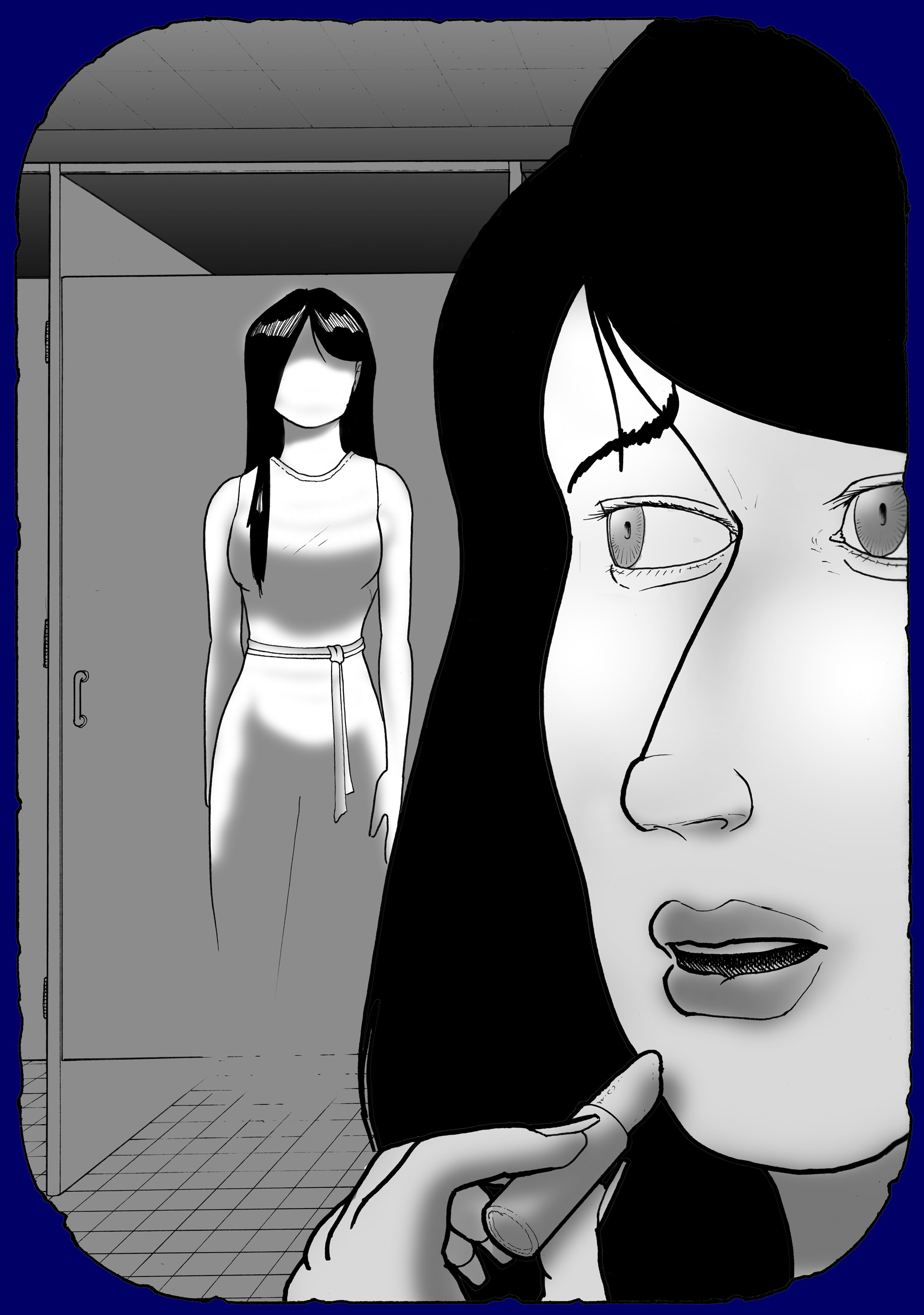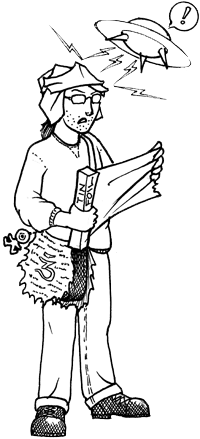| Area(s) Reported: Island of Oahu: Hawaii: USA
Date(s) Reported: May 19, 1959-1990... and possibly still happening
On May 19, 1959, an article in the Honolulu Advertiser signaled the start of a strange series of events that may still be occurring. Bob Krauss, author of the regular column called "in one ear," featured on that day various rumors and second-hand accounts that had started to circulate a week earlier about the Waialae Drive-In Theater in the city of Honolulu, on the island of Oahu, of Hawaii, USA. According to the rumors, something was very wrong about the ladies' restroom at the theater. Krauss had heard two versions of the story of what had supposedly happened at the drive-in and recounted both in his column, without any apparent belief on his part that either was true. The first story stated that a girl had gone to the restroom around midnight one night to freshen up her lipstick. As she was looking in the mirror to do this, she noticed a figure of a woman that appeared to be standing behind her... and the figure had no face, and no legs touching the ground. The girl spun around, but nothing was behind her; and then the door to the restroom slammed shut and locked by itself. She screamed and fainted. The second version of the story claimed that when the girl had gone to the restroom she found that she wasn't alone, as another woman was standing at the sinks looking in the mirror and combing out her "long, beautiful hair." The girl walked over and said something, presumably a simple greeting, and the second woman turned slightly to look at her. The second woman had no face. In both versions of the story, it was asserted that the terror of the moment caused the girl to end up at a hospital with a total breakdown. Krauss noted that the drive-in had been built next door to a cemetery which, he supposed, might lead to spooky happenings. Krauss had called Albert Silva, the manager of the drive-in, to see if he could shed any light on the strange stories. Silva hadn't seen the ghost and asserted that "Of course, there's not a bit of truth in the ghost story." He was, however, delighted with the effects of the story: the theater had been packed each night after the tale became well-known, full of not just movie-goers but curious ghost seekers as well. Silva mentioned that about a week earlier, a woman had come to tell him that her friend had seen a faceless ghost in the restroom. He asked the woman to bring her friend to him so he could meet her, but she never did. He postulated that the then-current set of stories may have stemmed from that incident. No one had ever reported a woman being injured or fainting in the ladies restroom, and Silva stated that he knew there was a girl who liked to play pranks at the theater -- like slipping paper under the restroom doors to scare people or locking the doors -- but he hadn't caught the girl in the act yet... implying that he felt the whole situation started as one of that girl's pranks. Urban Legend Gone Wrong Around twenty years later, a folklorist named Glen Grant became interested in Krauss' article about the faceless ghost of the Waialae Drive-In. Noticing that the article didn't actually have any eyewitnesses to the supposed ghost, Grant felt the story of the faceless woman was clearly a good example of an "Urban Legend," a story that gets told as true even though it isn't, simply because people like the story or want it to be true. Urban Legends often have small details change in their re-tellings, but hang onto a central theme or idea... so in this case the central theme was a faceless woman in the drive-in's restroom, and the changing details were about who saw her, what the encounter was like, and what the results were. Another key feature of an Urban Legend, and the main reason Grant suspected the faceless woman stories of being one, is that all accounts are said to have happened to someone other than the storyteller themselves, and not someone the storyteller themselves directly know... a situation described as "a friend of a friend," thus setting a sort of distance to the ability to investigate. With this impression of the matter, in November 1982 (or 1981) when Grant was on a Oahu local radio show talking about Hawaiian ghost stories and was asked by a listener if he had ever heard of the faceless ghost of the Waialae Drive-In, he immediately answered that he had and then reassured the listener that it was merely an Urban Legend. The anonymous caller disagreed with this assessment. She then told Grant and the radio's audience that in 1980 she had gone to the ladies restroom at the drive-in and found another girl inside standing in front of the mirror and combing her long red hair. The caller, who hadn't heard about the supposed haunting in the restroom at the time, walked to the sink next to the redhead to use it... and then saw the redhead had no face under the hair. She screamed and ran from the restroom and, by the time her friends investigated, no one was there. Which means Grant was faced with the fact that the faceless woman of the Waialae Drive-In was now an eyewitnessed account, and by someone who didn't know the story previous to their encounter. It was certainly not just an Urban Legend. The Faceless Woman Roams Due to this radio incident, Grant found himself the center of people who wanted -- needed -- to report their own or their friends' encounters with the faceless woman... and, while he thought this might stop after the Waialae Drive-In was demolished in 1986 so the area it had occupied could be turned into a housing development, the reports continued to reach him until at least 1995, which is the last report I know that he has written about. Of these reports, I will now present only the ones that he received as firsthand eyewitness accounts; and I think you'll see that's enough in this case. In 1965, a young man was at the drive-in with his girlfriend (who later became his wife) when during the second feature she asked him to escort her to the restroom because she didn't want to walk across the theater's lot alone. He waited outside as she went in; and a minute later she screamed and ran from the restroom. He glanced past her to see what the problem was, and saw what she had seen -- upon entering she had gone to a stall only to find it occupied by a faceless woman with no legs, floating above the ground, which her boyfriend then saw coming after her when he glanced into the restroom. In November 1989, three years after the Waialae Drive-in had been torn down, the faceless woman appeared in the basement of a hospital in Honolulu. Two mechanics were working in the boiler room in the basement of the hospital when, around 1:00 AM, they both saw a woman in a hospital gown coming down the hall towards them. She was walking very slowly and unevenly, and was stooped over. The two mechanics both assumed she was just a patient who had gotten lost, so one of the two called out to her to ask if she needed help, and what room she was from. She looked up, tucking her long black hair behind her ears... this time, the strange woman was not just faceless; the place her head should have been was, as one of the men later explained to Grant, "a dark tunnel under her hair, going endlessly into nothing." The men fled the basement immediately. Grant noted that, as the mechanic described the encounter to him, the man was shivering with fear even though over a year had passed. Late in the year of 1990, an older couple living on Ewa Beach Road were getting ready to retire for the evening when they heard a strange, but distinct, sound outside on their driveway. The sound was that which is made by geta, a old type of Japanese wooden sandal; and it was around 10:30 PM when they heard it. Curious about who it could be, they soon saw there was a very old woman with white hair done up in a bun, wearing a red Japanese kimono and carrying a red umbrella, who was coming down the driveway towards their house. She was an interesting site, even "cute;" and the couple watched her approach, taking tiny steps, until the woman was passing their window... and turned her featureless face towards them. They both let out a shout; then continued to watch as the old lady walked on, this time out of fear instead of curiosity. The faceless old woman walked past the far side of their car; they could see the top of her umbrella marking her progress as she passed the vehicle, but her body was not visible through the windows! The strange figure then walked into their garage and vanished. By the next day, both of them were doubting what they had seen... until the neighbors asked them who the lady in the red kimono was that had visited their house. One Further Weirdness You would think a faceless woman was enough of a haunting for any drive-in to begin with... but one of the eyewitness accounts that Grant was told added even more strangeness to the whole matter. According to one informant, he had been at the drive-in one night in 1969 when he and everyone else attending the movie saw a three-foot wide fireball lift up out of the theaters' ground, fly about thirty feet up into the air and then shoot around above the automobiles that were parked at the drive-in, finally hurling itself into the screen of the theater. And now let me share something I know which might be related, but oddly. In Japan, ghosts are traditionally illustrated as having no visible legs; their bodies are shown to taper off into nothingness where they should be standing on legs. This is an artistic motif in Japan, started by the Japanese artist Maruyama Okyo [1733-1795]. Maryuama's paintings and illustrations of footless spectres proved very popular for him, and so artists that were trained by him continued this motif in their art... so, to this day, it's common even in Japanese comics to display the lower bodies of ghosts as fading away to nothing. Hawaii has a large population of people descended from Japanese immigrants -- about 23% -- and some monsters usually associated with just Japan have been reported in Hawaii as well... so it's possible that the reports of the Faceless Woman having no feet are related to the old Japanese tradition of depicting ghosts with no feet. Except, and this is where we get "iffy": not everyone reporting the footless spectre was Japanese and, even in Japan, most reports of actual ghosts are of full figures... so the footless ghost motif really seems to be more of an artistic style than a representation of what people report. It's still an odd connection, however. Glen Grant died in 2003, so if the faceless woman is still haunting the island of Oahu, there is no longer a known person these events are being reported to. Perhaps there are more accounts of the faceless woman in Grant's papers waiting to be discovered... and maybe the spirit is still appearing in different places across the island, quietly. While I don't know if the faceless woman is still active or not, I'd sure love to found out if she is! | |







